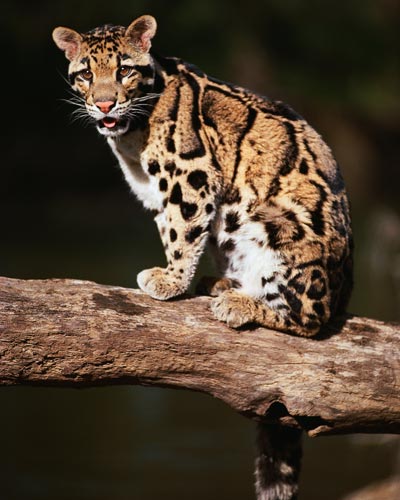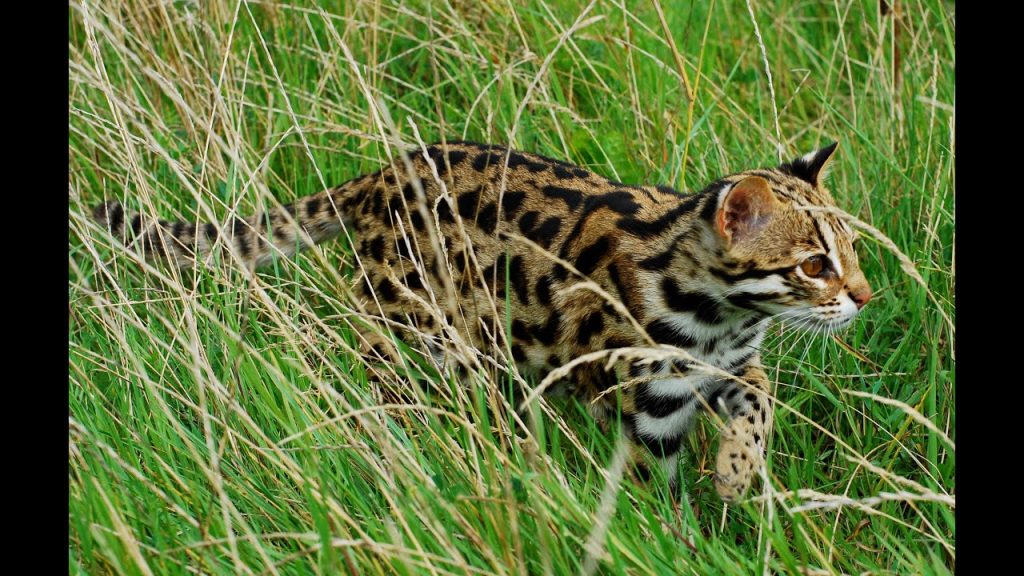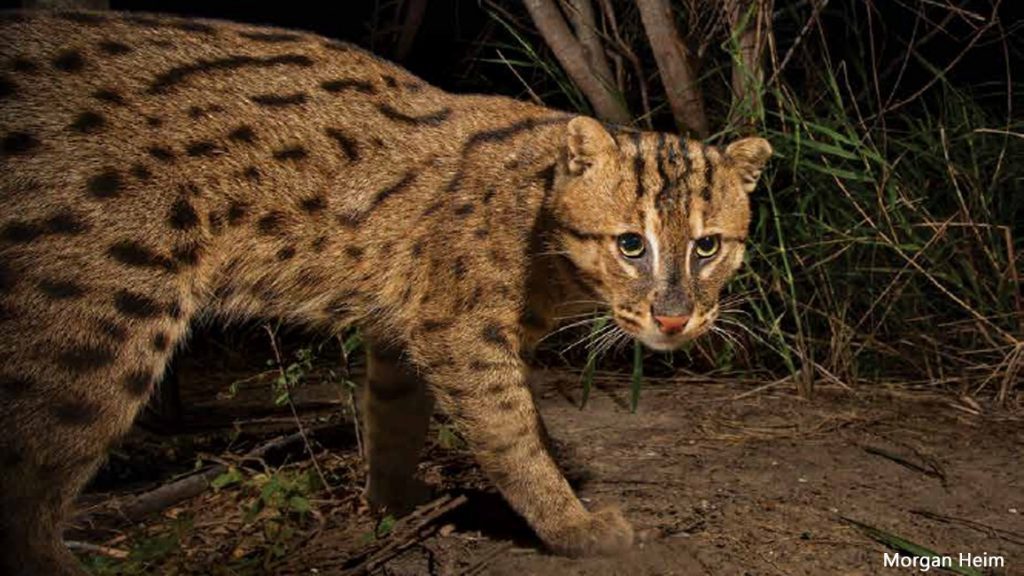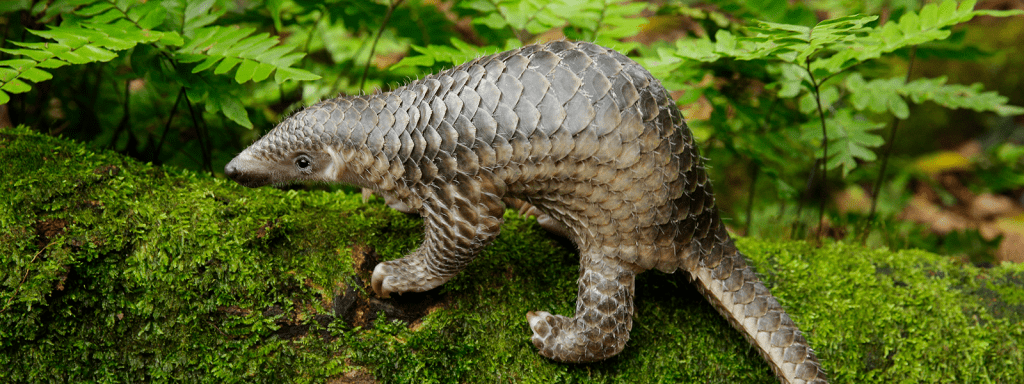CNE’s look at the 250 odd mammals native to the kingdom continues with the family Felidae.
Not the horrible things with half tails that kill birds for the lols and spray wee everywhere while tearing up your curtains. We hate them. Only crazy old ladies and naive hippies in Kampot like those awful animals. These are the real deal, OG pussies, which sadly, like so many of the critters featured in these articles are seriously under threat, thanks to humans.
Asian golden cats, are known as the “fire cat” in Thailand and Burma, and as the “rock cat” in parts of China.

Their fur ranges in color from cinnamon to various shades of brown, and also gray and black (melanistic). There are some cats with spotted and striped markings, in appearance similar to an ocelot. Sometimes there are stripes on the cat’s head and cheeks as well. Their ears are black on the outsides and gray on the insides. The cat’s underside is usually white.
The Asian golden cat occurs in Southeast Asia, from Nepal and Tibet to Southern China, Sumatra and India. It prefers forest habitats that are interspersed with rocky areas, being found in deciduous, tropical and subtropical evergreen rainforests. In Cambodia it has been found in the Cardomoms and the northeastern forests.
Asian golden cats are solitary and territorial. Once considered nocturnal, a radio-tracking study showed them to be diurnal and crepuscular. Although they can climb well, most of their time is spent on the ground, their long tail being curled up at its tip. Little information regarding the communication of Asian golden cats is available, as observing them in the wild is difficult.
Asian golden cats are carnivores, often eating small prey like ground squirrel, small snakes and other reptiles, muntjacs, rodents, birds, and young hares. They have been known to prey on domesticated sheep, goats, and poultry.
Asian golden cats are under threat by the habitat destruction that follows deforestation, as well as a decreasing numbers of prey. Another major threat is the illegal wildlife trade, as well as hunting by tribal people for meat and skin to use in tribal rituals.
According to the IUCN Red List, this species’ numbers are decreasing and currently it is classified as Near Threatened (NT).
Clouded leopards dwell in the cloud forests of Southeast Asia and are one of the most ancient cat species. However, they are neither a true great cat nor a true small cat, because they cannot roar or purr. Poaching and habitat loss threaten this vulnerable species.

While more closely related to big cats, the clouded leopard is frequently described as bridging the gap between big and small cats due largely to its smaller stature. It has proportionately short legs and a long tail.
While all species of cats are classified as one family, the Felidae, genetic research has shown the clouded leopard to be most closely related to the large cat species. Clouded leopards are not a “type” of leopard as their name implies. They are a separate species of wild cat, as are snow leopards and leopards. Recent research has proposed the clouded leopard branched from other members of the Pantherinae family first—over 6 million years ago—making them the most ancient feline species in the modern cat world.
Males weigh up to 23 kilograms. Females are significantly smaller, usually 11 to 21 kilograms
Due to a different bone structure in their neck, the clouded leopard cannot roar like the larger cats, but also cannot purr because it lacks the fully ossified hyoid bone that allows small cats this ability. Vocalizations include growling, hissing and chuffing.
Little is known about the behavior of clouded leopards in the wild, although conjectures are made based upon observations of animals in captivity. They are regarded as secretive and rarely seen arboreal hunters that are most active at night, although these characteristics vary. Large feet, short legs, and a long tail make clouded leopards well-adapted for arboreal living.
They are extremely adept in trees, and they have been observed engaging in acrobatics such as climbing slowly head first down tree trunks, hanging upside down while moving along horizontal branches, and hanging from branches using only their hind feet. Clouded leopards are able to hunt in the trees, preying on birds, monkeys, and rodents. Clouded leopards are not strictly arboreal hunters, they may spend more time resting in trees than hunting. Using trees as refuges is thought to be a means of escaping the terrestrial leeches found in tropical forests in Asia; they also protect these cats from larger predators, such as leopards and tigers.
Hunting for pelts and body parts, as well as habitat and loss of prey, has pushed these rare cats to extinction in many areas. There are reported to be small numbers left in the Cardamom range and the northeast of Cambodia.
The Marbled cat can be seen as a miniature clouded leopard, with a body length of up to around 60 cm and a weight up to 5 kg.

Its fur is thick and soft and varies in color from brownish gray to yellow to reddish brown, covered in large patches, which are paler in the middle. It has black spots on its legs and a few black lines on its head and neck. The Marbled cat has a short head, more rounded than other cats, and a wide forehead with large pupils. As with the Clouded leopard, this cat has relatively large upper canines. Its tail is bushy and very long, well adapted to its life in the trees.
In Cambodia they are thought to inhabit the far northeast, close to the Thai border.
Marbled cats primarily prey on birds and small arboreal mammals. Mammals they eat include tree squirrels, tree shrews, mice and rats, fruit bats and small primates. Their primary prey is thought to be birds up pheasant size. They also eat lizards, frogs, and insects.
They are territorial animals and their home range usually covers a territory the size of 2.2 square miles. The Marbled cat is characterized as being very active, with a great capacity to climb and jump. Their front feet have webbed and flexible paws which feature heel pads that are twice as wide as their length. Their claws are retractable and are double-sheathed, so they are well suited for climbing.
Marbled cats are comfortable on the ground as well. Their behavior and morphology indicates that these are semi-arboreal animals. Like the domestic cats, marbled cats have been seen purring. Their meow has been compared to chirping instead of a more continuous sound inflection. These cats rely heavily on their vision, which in low light is very good.
The major threat to the Marbled cat is thought to be widespread and rapid destruction of the forest habitat within Southeast Asia, affecting not only this species, but its prey as well.
According to the IUCN Red List, the global population size of Marbled cat has not been quantified, but it is likely that it numbers over 10,000 mature individuals. This species’ numbers are decreasing today and it is classified as Near Threatened (NT) on the IUCN Red List.
Jungle cats, Felis chaus fulvidina, prefer habitats near water with dense vegetative cover.

Jungle cats range in size from 70 to 120 cm long and 35 to 38 cm tall. They weigh from 4 to 16 kg. Adult males are larger and heavier than adult females.
Except for breeding season, jungle cats live solitary lives. They are most active at night, but are not strictly nocturnal. They are more often seen at dusk and travel approximately 5 to 6 km per night. They typically rest in dense cover during the day but often sunbathe on cold days. Unlike most cat species, jungle cats have an affinity for water and are proficient swimmers that will dive into water to catch fish with their mouths.
Jungle cats feed primarily on rodents, which provide up to 70% of the cats daily energy intake. They are often spotted hunting near villages and farms where rodent populations tend to be higher and are sometimes viewed as pests themselves.
Habitat destruction and persecution by humans are the main threats to jungle cats. As the human population increases, more land is cultivated and jungle cats’ natural habitat is converted to farmland. Although they are very adaptable, these altered environments do not support the same density of cats. In addition, farmers often hunt and poison jungle cats for attacking and killing poultry and are also poached for their fur.
Although laws have been implemented to protect them, illegal trade still continues in many countries. For example, over the last decade more than 3,000 jungle cat skins have been seized across the globe. Currently, jungle cats are considered as a species of “least concern” by the IUCN, however, population numbers are currently declining.
Leopard cat, (Prionailurus bengalensis), forest-dwelling cat, common across Asia. The leopard cat is noted for its leopard-like colouring.

The coat of the leopard cat is usually yellowish or reddish brown above, white below, and heavily marked with dark spots and streaks. Length of the animal ranges from 45 to 75 cm, with at 23–35-cm long tail. The leopard cat is a nocturnal hunter, preying on birds and small mammals (including domestic fowl in some areas).
Leopard cats are thought to have formed a commensal relationship with farmers in some parts of China during the late Neolithic Period to protect granaries from rodent infestation. The leopard cat’s rodent-hunting services were replaced by those of the common domestic cat (Felis catus), which was also kept as a household pet, sometime after 3000 BCE.
Leopard cats can be cross bred with domestic cats, making the Bengal domestic breed.
They are hunted for pelts and for the wildlife trade. Due to the wide range across most of Asia, they have a conservation status of Leact Concern.
The Fishing cat, (Felis viverrina), is found in India and Southeast Asia.

The coat of the fishing cat is pale gray to deep brownish gray and marked with dark spots and streaks. The adult animal stands about 40 cm ( at the shoulder, weighs 8–11 kg, and is from 60 to 85 cm long, excluding the black-ringed tail, which accounts for an additional 25–30 cm.
The fishing cat lives near water and in jungles, reed beds, and marshes. It is reported to fish by scooping its prey out of the water.
The fishing cat is thought to be primarily nocturnal, and is very much at home near water. It can swim long distances, even under water. Fish make up the largest part of the cat’s diet, but they are known to eat rodents, insects and reptiles.
In March 2003, a single fishing cat was photographed by a camera trap in Kulen Promtep Wildlife Sanctuary, northern Cambodia.[ In 2008, a fishing cat kitten was found in Botum-Sakor National Park, southwest Cambodia.In 2015, fishing cats were also recorded in a coastal wetland in Cambodia.
Loss of wetland habitat and water pollution caused a decline in the number of animals in the wild. They have a Vulnerable conservation status.
The Indochinese leopard (Panthera pardus delacouri) once had a range across the region, but is now on the brink of extinction, losing 94% of .

There are few areas left where leopards have a chance of long-term survival. They are primarily threatened by habitat destruction following large–scale deforestation, and prey depletion through illegal hunting.][
An increasingly growing threat is hunting for the illegal wildlife trade as leopards are increasingly being used as substitutes for tiger parts in traditional Chinese medicine, with the price of leopard parts rising as tiger parts become scarce.
The Indochinese tiger, which once roamed the forests of northern Cambodia has not been seen in the country for over a decade and is currently thought of as ‘functionally extinct’.

Cambodia once had one of the highest tiger populations in the wild, but over just a few years from the late 1990’s, the species was annihilated by poaching and habitat loss. There have been calls to reintroduce the species back into the country.
(Not a cat, but has to go somewhere)
The Sunda pangolin (Manis javanica) is native to Southeast Asia.

The Sunda pangolin is the most widely distributed species of pangolin in Southeast Asia. While its geographic range overlaps with that of the Chinese pangolin, it can be distinguished by fewer rows of scales across the back, shorter forelimb claws, and a longer more slender tail.
It also spends more time in trees than the Chinese pangolin.
Pangolins as a genus are among the most heavily poached and exploited protected animals. Like other pangolin species, the Sunda pangolin is hunted for its skin, scales, and meat, used in clothing manufacture and traditional medicine. Scales are made into rings as charms against rheumatic fever, and meat is eaten by indigenous peoples.
Despite enjoying protected status almost everywhere in its range, illegal international trade, largely driven by Chinese buyers, has led to rapidly decreasing population numbers. The Sunda pangolin is currently considered to be critically endangered.[
As of 2016, all pangolin species, including the Sunda pangolin, are listed by CITES in its Appendix I, which prohibits international trade in wild-caught specimens or their body parts.
Read more:
Critters I- The Furries
Critters II- Bat Country

Beautiful animals, thanks for this! May we protect wildlife for the future.